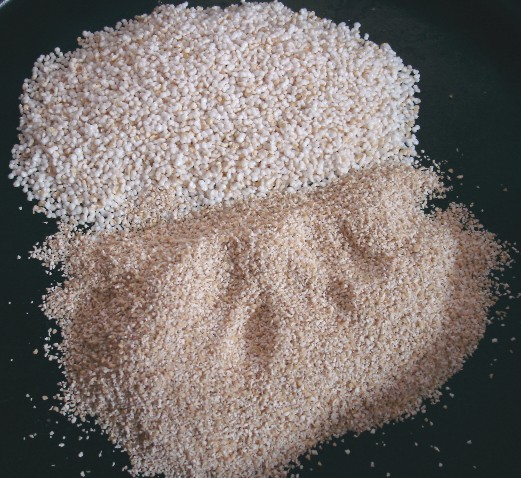
Nutritionists classify dietary fiber as either insoluble fiber or soluble fiber, depending on whether it dissolves in water. (Both kinds of fiber resist human digestive enzymes.)
- Insoluble fiber: This type of fiber includes cellulose, some hemicelluloses, and lignin found in whole grains and other plants. This kind of dietary fiber is a natural laxative. It absorbs water, helps you feel full after eating, and stimulates your intestinal walls to contract and relax. These natural contractions, called peristalsis, move solid materials through your digestive tract. By moving food quickly through your intestines, insoluble fiber may help relieve or prevent digestive disorders such as constipation or diverticulitis (infection that occurs when food gets stuck in small pouches in the wall of the colon). Insoluble fiber also bulks up stool and makes it softer, reducing your risk of developing hemorrhoids and lessening the discomfort if you already have them.
- Soluble fiber: This fiber, such as pectins in apples and beta-glucans in oats and barley, seems to lower the amount of cholesterol circulating in your blood (your cholesterol level). This tendency may be why a diet rich in fiber appears to offer some protection against heart disease.
Here’s a benefit for dieters: Soluble fiber forms gels in the presence of water, which is what happens when apples and oat bran reach your digestive tract. Like insoluble fiber, soluble fiber can make you feel full without adding calories. Ordinary soluble dietary fiber can’t be digested, so your body doesn’t absorb it. But in 2002, researchers at Detroit’s Barbara Ann Karamonos Cancer Institute fed laboratory mice a form of soluble dietary fiber called modified citrus pectin.
The fiber, which is made from citrus fruit peel, can be digested. When fed to laboratory rats, it appeared to reduce the size of tumors caused by implanted human breast and colon cancer cells. The researchers believe that the fiber prevents cancer cells from linking together to form tumors. Now, two pharmaceutical companies — one on the East Coast and one on the West Coast — are investigating the effects of modified citrus pectin in human beings. But the product isn’t yet ready for prime time. Although it’s being sold as a dietary supplement (not as a medicine), experts warn that its effects on human bodies (and human cancers) remain unproven.






 Alcohol beverages are among mankind’s oldest home remedies and simple pleasures, so highly regarded that the ancient Greeks and Romans called wine a “gift from the gods,” and when the Gaels — early inhabitants of Scotland and Ireland — first produced whiskey, they named it uisge beatha (whis-key-ba), a combination of the words for “water” and “life.” Today, although you may share their appreciation for the product, you know that alcohol beverages may have risks as well as benefits.
Alcohol beverages are among mankind’s oldest home remedies and simple pleasures, so highly regarded that the ancient Greeks and Romans called wine a “gift from the gods,” and when the Gaels — early inhabitants of Scotland and Ireland — first produced whiskey, they named it uisge beatha (whis-key-ba), a combination of the words for “water” and “life.” Today, although you may share their appreciation for the product, you know that alcohol beverages may have risks as well as benefits.


